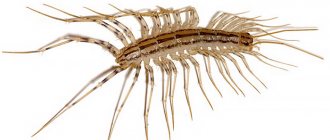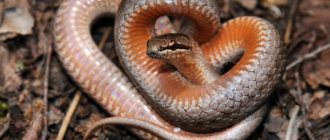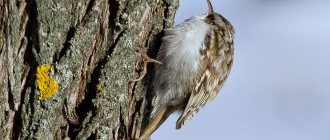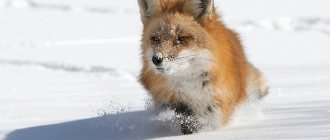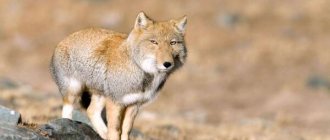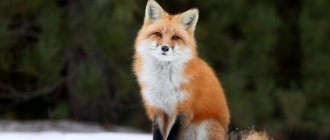The red fox or common fox is the largest representative of the fox genus from the Canidae family. The animal has an elongated muzzle and a fluffy long tail, which the fox uses as a warm blanket to cover its nose and front paws while resting.
The tail can reach sixty centimeters in length. The fur of a fluffy fox is long and beautiful, and also very warm. Depending on the habitat, the color and tonal saturation of the fur may vary, but basically the back and sides of foxes are bright red, and the belly is white.
The characteristic black stockings or blotches are clearly visible on the paws. But the main distinguishing feature of the red fox is of course the white tip of the tail and sharp black ears.
The fox's paws are quite powerful and muscular, despite the fact that they are a little short. Thanks to them and an even more powerful tail, the fox makes very decent jumps in pursuit of prey.
These qualities enable the fox to be in no way inferior to many predators in the struggle for life.
Foxes, bred in captivity on fur farms, come in unusual platinum and silver-black colors.
If a fox with a fur coat of this color manages to escape and catch the eye of hunters, it becomes the object of instant persecution, because... Fox skins of this color are very valuable.
Appearance
The appearance of a mammal depends on its habitat. There are more than 40 subspecies in the world, differing not only in lifestyle, but also in appearance. Individuals living in the northern regions are larger and have light fur. Residents of the south are small and have dark fur. The most common color is a bright red back, white belly and dark (almost black) paws. Often there are cross-shaped brown stripes on the shoulder blades and spine. Dark ears and a very light end of the tail are a common feature of almost all individuals.
Typical color of a common fox in winter
Foxes are graceful, medium-sized animals with thin, low legs, a sharp muzzle, large erect ears and a very long shaggy tail. The animal sheds from February to mid-summer. New fluffy fur grows completely by November-December.
Three main steps to drawing a fox in watercolor
The wet-on-wet technique is used to depict the basic shape.
A dry brush adds volume to the masterpiece, gives shape and outlines the texture of the fur.
A thin brush does a great job with small details such as nose, eyes, mustache.
You must have:
- Plain white and special paper for writing in watercolors;
- A set of brushes: a thin brush - for drawing small details, a medium one - for completing the main part and a large one for wetting the paper with water;
- Watercolor paints
- Paper tape
- Tablet (preferred)
- White gouache
- Glass of water
- Napkins
- Regular pencil
Habitats
Animals can live on different continents. They are found in Europe, Asia, Africa, South and North America, and Australia.
Foxes settle on the slopes of ravines and hills; they choose sandy soil. Burrows must be protected from flooding with melt water and rain. Animals most often occupy someone’s burrows and less often dig them themselves. The main condition is that the home must have several exits. Some individuals do not disdain tree hollows and caves, settling directly in them.
Habitat of the common fox
Nutrition
The main diet of all foxes is rodents. Much less common prey is hares, baby roe deer, small birds, as well as feathered eggs and reptiles. During periods of hunger, the animal eats carrion. Individuals living along fast-flowing rivers eat salmon that die after spawning. In summer, they feast on insects and their larvae. However, despite the fact that foxes are typical predators, they do not neglect plant foods (berries, fruits) and cereals in a state of milky ripeness.
A fox can catch a hare
How to hunt
Foxes are excellent hunters. They are observant and smart, have keen hearing and sense of smell, and have good visual memory. The animals run, swim and climb quickly.
When hunting birds, the animal shows great cunning. It walks nearby and pretends that it is not interested in the potential victim. Birds lose their vigilance and become easy prey.
In winter, foxes hunt voles. They listen with their large ears to the sounds under the snow cover, to all the rustles and squeaks, and then quickly dive under the snow or tear it with their paws. This method of hunting is called mouseing.
Winter hunting for voles
Foxes do not leave uneaten food, but try to hide it. Subsequently, they find these hiding places and happily feast on or treat their offspring.
What does a fox eat and who does it hunt?
The red fox is a predator, so its diet is appropriate: small animals, rodents, hares, destroy the nests of wood grouse and geese, hunt roe deer cubs, and do not disdain carrion, various insects and beetles.
Well, domestic hens and chicks, when the fox manages to get into the chicken coop, become tasty prey.
The most interesting thing is that foxes often destroy various cereals, in particular oats, when there is no way to get to anything meaty, and cause significant damage to agricultural crops.
It’s not for nothing that the fox is called cunning; she has a huge number of different ways of hunting and catching prey.
The fox simply pushes the hedgehog into the water so that it opens up and can be grabbed by the stomach, where there are no needles. It easily identifies mice, gophers and other rodents by sound and digs them out from under the snow in winter. In general, mice are a well-known delicacy for foxes, and in some regions the population of common individuals depends directly on the number of rodents.
Foxes hunt geese in pairs, while one fox distracts the gaping goose, the second quickly attacks the prey.
Foxes hunt around the clock when prey is discovered, but of course night is the main time for hunting.
When a fox walks through the snow, it places its hind paws strictly in the tracks of its front paws, forming a kind of chain. Foxes that live near rivers eat fish with pleasure and are often caught during spawning or in shallow water.
In total, the diet of the red fox includes about four hundred species of animals and several dozen species of plants.
Foxes living in the desert are content with the meat of various snakes and lizards.
Lifestyle
Most foxes are nocturnal. They hunt mainly in the dark, and during the day they hide in their burrows. Thanks to their excellent vision, the animals can easily navigate in the dark.
Most often, these mammals live alone, sometimes in groups of several individuals (usually for the breeding season), without gathering in packs. They always mark their territory with excrement to prevent strangers from encroaching on their home.
Foxes in the night forest
Chanterelle in a couple of minutes
If you are a beginner artist and have picked up a pencil for the first time, then most likely you still doubt your abilities. To strengthen your faith in your abilities, try to portray such a cute red-haired cheat.
The job description is available to every student and anyone can cope with it without difficulty in literally five minutes.
All you need is to be familiar with a geometric figure such as a triangle.
Reproduction
The mating season for the animal begins in late January - mid-February. By the onset of March, one female is already courted by several males, who often fight.
During the rutting period, foxes are very excited and create a lot of noise, especially those who have not acquired a mate. Representatives of different sexes have different voices. Males bark like dogs, and females bark three times and end with a short howl. Left alone, predators perform funny “dances”: they stand on their hind legs and move in small steps. It is from this dance that the foxtrot gets its name.
Fox and cubs
Males take an active part in raising offspring. They also take care of pregnant females even before the babies are born: they arrange sleeping areas and obtain food.
Pregnancy in foxes lasts 51–53 days. A litter can range from 4 to 12 cubs, but in most cases about 5–6 foxes are born. They are weak, defenseless, deaf and blind, most often weigh no more than 150 g. Little foxes grow very quickly, within a month after birth, all their senses begin to work, and their body weight reaches 1 kg. During this period, the fox cubs come out of the hole and begin to play and indulge a lot. In order for the kids to quickly acquire hunting skills, the male and female bring them half-dead prey.
If a person accidentally finds a fox's shelter, then with the onset of darkness the fox cubs will be moved to a spare hole. When the offspring are in danger, adults try to get their children out through additional passages until the last moment.
Fox cubs in the hole
Fox tracks
Prints of a fox's right pair of paws
a - front paw of a fox, b - hind paw of a fox
Foxes, like the vast majority of animals of the canine family, have 5 toes on their front paw (African hyena dogs have 4 toes on their front and hind paws), but the 1st toe (located on the inside of the paw) is located high, and on no trace of him is visible. The prints of both fox paws are four-toed.
A fox footprint is similar to a small dog's paw print, but is more elongated and slender. The impressions of the crumbs of the lateral fingers are moved further back, and often an almost even line or a match can be drawn between their anterior edges and the posterior edges of the two middle fingers. Often this feature of fox paw prints is cited as the main feature of the difference between fox tracks and dog tracks, the lateral toes of which protrude quite far beyond the rear edges of the front toes.
However, in practice, especially in winter, when the soles of foxes are overgrown with fur and the contours of the toe pads on the tracks are less clearly visible, this sign is not very clearly expressed, and it is not always possible to fit the notorious match between the front and rear toes. If in doubt, follow the trail of tracks. If not immediately, then pretty soon the fox will switch to its usual gait and its tracks will stretch in an even chain - no dog walks like that.
The print of the fox's front paw looks somewhat larger than the print of the back paw due to its greater width. The size of the prints of the front paws of foxes from the central regions of Russia is (6.5–7.5) x (4.6–5.7), and the size of the hind paws is (6.5–7.0) x (4.0–4.8) ) cm. Located behind the fingers, the metacarpal soft tissue (“heel”) looks like an inverted heart. It is narrowed in front and widened below. Moreover, its outer lower edge seems to be pulled back more, which often helps to distinguish right-handed prints from left-handed ones. The posterior edge of this crumb is noticeably concave. The hind paw also leaves a four-toed imprint. Compared to the front one, it looks narrower and slimmer. The metatarsal soft of the hind paw is more rounded at the back and does not have a crescent-shaped notch. The side toes are usually set back a little more than on the front feet. The claws are usually slightly shorter than those on the front paws.
Behavior
This is a very cautious and peaceful creature. It will never attack unless absolutely necessary. Foxes fight only during the breeding season if they fail to divide the female. They try to avoid people and not catch their eye once again. However, despite caution, almost all individuals have remarkable curiosity. They will try to thoroughly examine any object that gets in their way and will interest the red animals.
Characterized by curiosity, but at the same time being careful
How long does he live?
Foxes live almost as long as wolves and wild dogs. However, due to harsh weather conditions, many individuals rarely survive to adulthood. The lifespan of an animal depends on the following factors:
- availability and quantity of feed;
- period of epidemics;
- the presence of enemies in a separate area of the terrain.
Lifespan of a fox
In the wild, wild foxes rarely live up to 6 years. Average life expectancy is 2–5 years. The animal spends all its time and energy searching for food and surviving in a difficult climate. In a zoo or at home, it can live up to 20 years.
Types of foxes
There are many varieties of foxes in the world. Animals differ not only in appearance and habits, but also in their habitat and dietary preferences.
Ordinary
This species can be found in Eurasia, South America and Africa. The standard size of an individual at the withers is about 80 cm.
The common coat color is reddish. Long white fluff usually grows on the chest, end of the tail and ears. Predators that live further north are usually larger and lighter in color. The length of the coat depends on the air temperature. When it gets colder, the fur lengthens and becomes thicker. The fox is characterized by short legs, an elongated body and large erect ears. The muzzle is slightly narrowed and extended forward.
Common fox in summer
Well-developed hearing allows the fox to hunt successfully. Prey most often are rodents, in more rare cases - roe deer or hares.
Korsak
Such foxes live mainly in the steppes of Southern Siberia, but are also found in the semi-desert territories of Iran and Azerbaijan, as well as in China and Mongolia. They differ from ordinary ones in their elongated paws and ears pointed at the ends, but they weigh much less - on average about 5 kg. The color is light gray, with black fur most often growing at the tip of the fluffy tail.
Korsak has very good hearing. Such foxes do not like tall and dense thickets; they never hide there, tracking down prey. They feed on rodents, hedgehogs and even insects.
Steppe fox Korsak
The animal spends the night in a hole, but does not dig a place for the night on its own. Most often, foxes occupy the shelters of badgers, gophers or other representatives of their own species.
Arctic fox
The animal also has another name - arctic. The predator lives in the tundra, as well as on the island territories of the Arctic Ocean, so it is almost impossible to meet it in the natural environment.
The arctic fox's body is low above the ground, its limbs are short, its soles are very rough and covered with thick fur. In nature there are two colors: snow-white and blue.
The animal is very active; it rarely settles in any place for a long time. The Arctic fox digs its own holes, and one of the entrances should lead to a reservoir. In winter, the animal takes refuge in snowdrifts.
Arctic fox
These foxes feed on rodents and birds, but can eat fish, plants and berries. If the arctic fox fails to find food for itself, it tracks down the bear on its way to hunt and feasts on the remains of its prey.
The Arctic fox is bred en masse on special farms. Asian and American factories make incredible profits from the valuable fur of this beautiful animal.
Bengal
Habitat: Indian territory. It is not found in sandy areas or in areas with dense, tall grass. It is found in forests, meadows and even mountain ranges. Rarely comes close to human habitation, because these mammals are often shot for sport.
Representatives of this species weigh only 3 kg. The coat is short, the color is reddish-red. The tip of the fluffy tail is covered with brown vegetation.
Bengal (Indian) fox
Males and females live together in a common burrow. The diet consists of rodents, bird eggs and some types of insects.
fennec
The animal lives in Asia and Africa. The animal is very small and weighs no more than 1.5 kg. The small muzzle is very pointed, the eyes are low set. The ears are very large and often exceed the dimensions of the head in length. The wool is soft to the touch. The color is cream with a red tint, and there is black fur at the tip of the tail.
The fennec fox loves to hide in dense vegetation and stalk prey. The color of the coat allows it to hide in desert areas. Thanks to the large size of its ears, such a fox is an excellent hunter, as it hears even the quietest sounds. The animal also has good eyesight, so it can easily navigate the terrain in the dark.
African fennec fox
The fenech feeds on small vertebrates, as well as carrion, bird eggs, and some plants.
Gray
Alternative name: tree fox. Such animals are very reminiscent of raccoons. They have black circles around the eyes, a pointed muzzle and a light brown color. They can boast of short red fur on their paws. The tail is very bushy, with a dark stripe running along its entire length. The fur is not very thick, so the animal is vulnerable to low temperatures.
Patagonian gray fox
The animal is distinguished by its dexterity. The fox can develop great speed and can climb trees. It is fertile and monogamous. If a partner dies, the fox is unlikely to form a new pair with another individual.
Darwinovskaya
This species was discovered by Charles Darwin and named after him. The beast was first spotted on the Chilean island of Chiloe in the early 19th century.
This fox is quite rare. It has short legs and thick dark gray fur. The weight of an adult can reach 5 kg. Monogamy is not typical for individuals of the Darwinian type.
Darwin's fox
Ostrovnaya
A rare endangered fox species can only be found in California on Channel Island. The animal is similar in size to a small dog. The fur is painted in several shades at once: brown, red, brown, white, black. Birds of prey often prey on the island fox.
Endangered island species
Afghan
Distributed in the Middle East. It has miniature dimensions and weighs about 2.5 kg. She has very long ears and short, light-colored fur. The animal is vulnerable to extreme cold. Sometimes there are individuals with dark fur.
The animal feeds on rodents and insects, and periodically consumes plant foods. Afghan foxes are prone to polygamy: they find a mate only for the mating period.
Afghan fox Vulpes Cana
Small
The species is found mainly in Africa. Its representatives settle far from human habitation and prefer to live near bodies of water. When meeting people they do not show aggression.
The animal has a massive body and short limbs. The fur is dark red or gray, the tail is black. A distinctive feature of the small fox is the sharp fangs protruding from its mouth. They are visible even with the mouth closed.
Little fox Atelocynus microtis
This species is endangered. It is possible to tame an animal, but in captivity it is not friendly and will growl at a person and try to attack.
African
The predator lives in desert areas and is perfectly camouflaged among sand and stones thanks to the shade of its fur. The fur is light brown, the muzzle is white. All individuals have long straight ears and large black eyes. At the base of the tail of African foxes there are specific glands with an odorous secretion.
African subspecies Vulpes pallida
Tibetan
Habitat: deserts of Tibet. Individuals have a non-standard appearance due to the abundance of hair on the cheeks; for this reason, the animal’s head appears square and large. The eyes are narrowed. The fur on the body is very thick and warm, so the fox is not afraid of the cold. The shade of the coat is light gray, sometimes with red or brown. Longer white fur grows on the chest.
The fox feeds on rodents, as well as birds and their eggs. The animal is often caught by Tibetans in order to sew warm, waterproof clothing.
Tibetan desert fox
big-eared
Such an animal can be found in African savannas. In appearance and other characteristics, it is not at all similar to ordinary foxes. The muzzle is small and pointed, the paws are short, the ears are wide and long, directed vertically. The fur is yellowish-gray, with the belly slightly lighter than the back. The paws have short black fur.
The fox rarely hunts rodents, preferring to eat insects. Representatives of this species are not afraid to approach human habitation.
Big-eared fox
American
This fox lives in desert and arid areas of the United States. It has a long neck, an elongated muzzle, wide ears and elongated limbs. The coat is gray-yellow, the belly is slightly lighter than the back. The soles of the paws are covered with thick hair.
Representatives of this species are among the fastest foxes on the planet. The animal digs holes like labyrinths, in which it orients itself well. It feeds mainly on rodents. The animal is monogamous, most often living with one partner all its life. However, sometimes there are males living with several females at once.
American fox Vulpes macrotis
Maikong
Animals of this species are found in South America. Maikongs resemble dogs and are not at all like ordinary foxes. Weigh about 8 kg or less. The fur is brownish-gray, sometimes showing red.
It feeds on rodents, but also loves sweet, juicy fruits such as bananas or mangoes. Maikong hunts with its relatives and exclusively in the dark. Such animals do not dig holes, but occupy other people’s homes.
Maikong lives in the savannah
Paraguayan
This fox lives in South America. Body weight exceeds 5 kg. The coat is yellowish-gray, with the back slightly darker than the belly. The tip of the tail is always black, as are the large expressive eyes.
Paraguayan foxes are excellent hunters. They prefer to eat rodents, but if they fail to hunt, they do not disdain snails or scorpions.
Paraguayan fox Pseudalopex gymnocercus
Andean
Found in South America. This is one of the smallest mammals on the continent. The fur is red or grayish. The tail is long and shaggy, covered with gray hair interspersed with reddish and black. It feeds on small rodents and plants. Does not neglect carrion.
Andean Lycalopex culpaeus
Sekuranskaya
Lives on the South American continent. The fox is small in size and weighs less than 4 kg. The fur is gray-red, sometimes there are dark stripes on the back that run along the entire body. At the end of the muzzle and chest there is short white hair. The Sekuran predator is often hunted by boa constrictors.
Sekuransky is distinguished by its yellow-brown paw color.
Brazilian
The beast can be found in Brazil, in forests, mountains and savannas. In appearance, the fox resembles a mongrel. The entire body is covered with short hair, with the exception of the paws, ears and tail, which has long fluffy fur. The eyes are large, mostly black.
Hunts during daylight hours. Due to its small teeth, it is not able to catch large prey, so most often insects (termites and grasshoppers) become food.
Lycalopex vetulus lives mainly in Brazil
Sandy
The fox lives in the desert territory of the African continent. A representative of this species has an oblong muzzle, large wide ears and a long tail covered with thick long hair. There are special fur pads on the paws that are designed to protect the limbs from overheating.
Hearing and vision are very well developed. She can go without water for a long time. Currently, the animal is at the stage of extinction, so hunting it is prohibited.
Sandy (Ruppel) Vulpes rueppellii
Characteristics and description
Darwin's
Foxes are gregarious animals. The group usually consists of a male, a female and their young. Burrows that have several exits in different places serve as shelter for animals.
Predators are predominantly nocturnal. Well-developed hearing and sense of smell help them navigate in the dark. Foxes' vision is focused on moving objects, which allows them to instantly react to the appearance of prey. Animals have a very good visual memory, which they often use during hunting.
The maximum speed of a fox is 50 km/h. Some species are capable of running at a speed of 60-65 km/h. Animals communicate with their relatives using a whole system of sounds. When communicating with the cubs, the female purrs; she can call a baby that has moved too far away by yelping. When in danger or during skirmishes, foxes emit a sharp, intermittent bark.
What sounds does a fox make?
What does a fox look like
Common fox
The external description of the animal has the following features:
- the body is elongated and very mobile;
- the paws are thin and sinewy, the hind limbs are longer, which allows the animal to make sharp jumps and turns;
- the muzzle is round, with erect large ears and a narrow, strongly protruding nose;
- the tail is long and fluffy;
- the teeth are sharp, and there are two pairs of long fangs on the upper and lower jaws.
Tibetan
The color and size of animals can vary significantly depending on their habitat:
| View | Habitat | Weight | Sizes and height | Fur color |
| Common fox | North America, Eurasia | 7-10 kg | Length - 90 cm, height at withers - 35 cm | Bright red color, turning almost white on the belly and dark, almost black, on the paws |
| Arctic fox | Northern regions of Eurasia and North America | 5-9 kg | Length - 70 cm, height - 30 cm | In winter - white, in summer - light brown |
| Tibetan fox | Endemic to the Tibetan Plateau | 5.5 kg | Length - 60 cm | The back is light brown, the sides are gray |
| Sekuran fox | Northwestern South America | 4 kg | Length - 60 cm, height - 35 cm | The back is gray, the belly is yellowish-brown. |
| sand fox | North Africa and Middle East | 3 kg | Length - 50 cm, height - 30 cm | Body pale brown, tail dark |
| Fennec fox (or big-eared African fox) | North Africa | 1.5 kg | Length - 30 cm, height - 20 cm | The back is light red, the belly and paws are white. |
fennec
Why is the fox called cunning?
Foxes are found in the folklore of many peoples, and everywhere the main quality attributed to them is cunning. Most likely, this reputation was assigned to the animal because of its behavior during the hunt: the animal carefully sneaks up on its prey, can track its prey by following its tracks and set up ambushes. The fox could also be called cunning due to its numerous tricks that throw hunters and natural enemies off the scent.
Keeping at home
Recently, people have increasingly begun to keep foxes as pets. The domestication of these animals began in the mid-20th century. Breeders have developed new breeds, but the animal's instincts remain the same. When purchasing a fox for your home, it is important to be very careful and not be lazy in raising it properly, because otherwise it can not only harm the household, but also destroy other pets or destroy the home.
As a rule, when in the house, trained females and males behave quite good-naturedly and obediently. They play with pleasure with their owner and pets, and easily learn various tricks.
The animal must be provided with special conditions. It is important to brush and bathe him regularly. Domestic foxes sleep in enclosures or on spacious bedding. Walking on the street is only possible on a leash.
Nutrition should be as close as possible to the diet in the wild. The basis of the menu should be meat, boiled or steamed, but not raw. The animal will not refuse fruits and vegetables, insects, and raw eggs. Feeding offal is encouraged. To prevent digestive problems, bones and unpeeled raw fish should not be given to the fox.
If desired, you can feed the animals food intended for dogs. However, even in this case, the fox must periodically receive vegetables, meat and other protein foods.
The cunning heroine of fairy tales
A serious and wise forest dweller is great, but sometimes you want something fun, like a cartoon image. It takes us to the world of childhood, where there was always a lot of joy and laughter. No matter how old people are, they always believe in miracles.
Let's, drawing a magical hero, be transported for a while to a fairy-tale world.
Its design is quite simple - several ovals as a base, which just need to be slightly changed in shape to get a cute face, small paws, pointy ears, and a chic tail.
And if you are not lazy and after you have drawn the fox with a pencil, paint it with bright colors, then you can make it the main character of your exciting story.
Enemies in the wild
Adults and their offspring are often attacked by wolves and other predators that are larger than them (bears, lynxes). Sometimes they become prey for badgers, stoats and even tigers. Small animals are subject to attacks by birds of prey (eagles, hawks, falcons). At the same time, a fox cannot be called an easy prey; it is cunning and resourceful, it can run quickly, hide and climb trees.
A fox can become prey for a golden eagle
The most important enemy for foxes is man. People hunt these beautiful animals for their valuable fur or simply for fun and excitement. Some species are on the verge of extinction, but poachers continue to exterminate them uncontrollably.
Economic importance
The predator is of great economic importance. It is not only a valuable fur-bearing animal, but also a regulator of the number of rodents and insects. Of course, red beauties sometimes cause considerable damage to farms, killing chickens and other domestic animals, but their benefits are much greater. They help protect grain supplies by killing small rodents.
People breed foxes on special farms to obtain valuable fur. For these purposes, in the 19th century, a special species was bred - the silver fox. With the help of selection, other breeds with high quality fur appeared.
Silver fox breeding farm
The fox is a mammal with perfect hearing and other hunting qualities. The cunning animal adapts to different climatic conditions and can feed not only on animal, but also plant foods. Such a predator can be kept in an apartment or house, but it is important to provide suitable conditions so that it remains docile and non-aggressive.
Caution
For those who are wondering how to distinguish a fox from a fox, the answer is: by behavior. If a fox approaches a person, it will prefer to retreat. Females are much more careful than their gentlemen. Foxes, on the contrary, will freeze in place, looking at the person. They won’t come close, but they won’t run into the forest either.
There are cases when red-haired rogues came out to people, even to hunters. When the latter raised their guns, the foxes quickly disappeared from view. And then people noticed how someone was watching them. This someone turned out to be a fox, sneaking after the uninvited guests.



